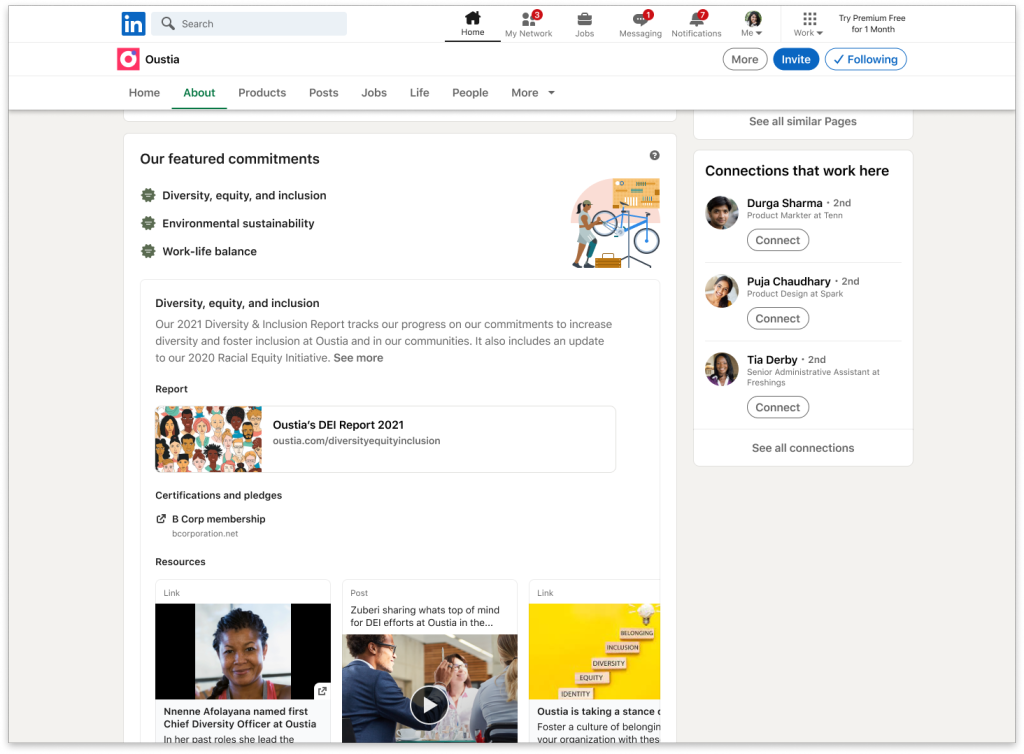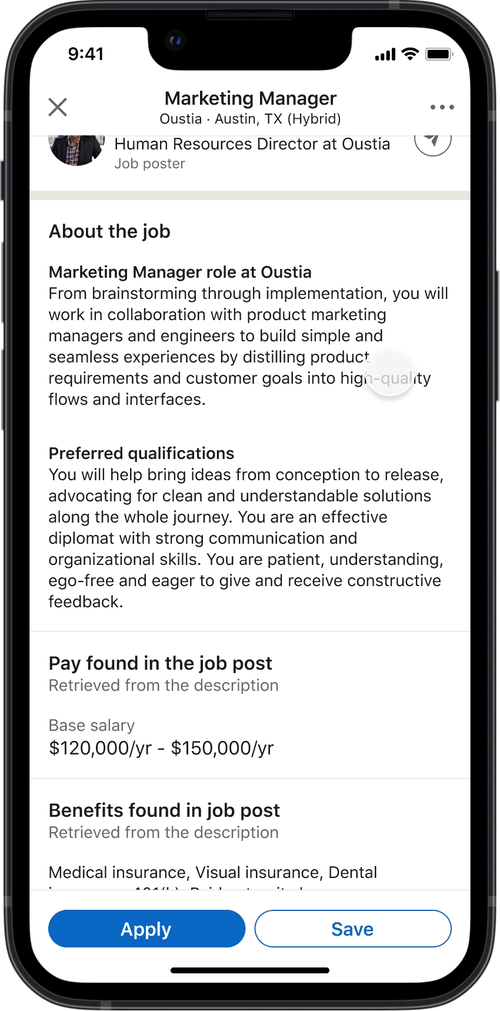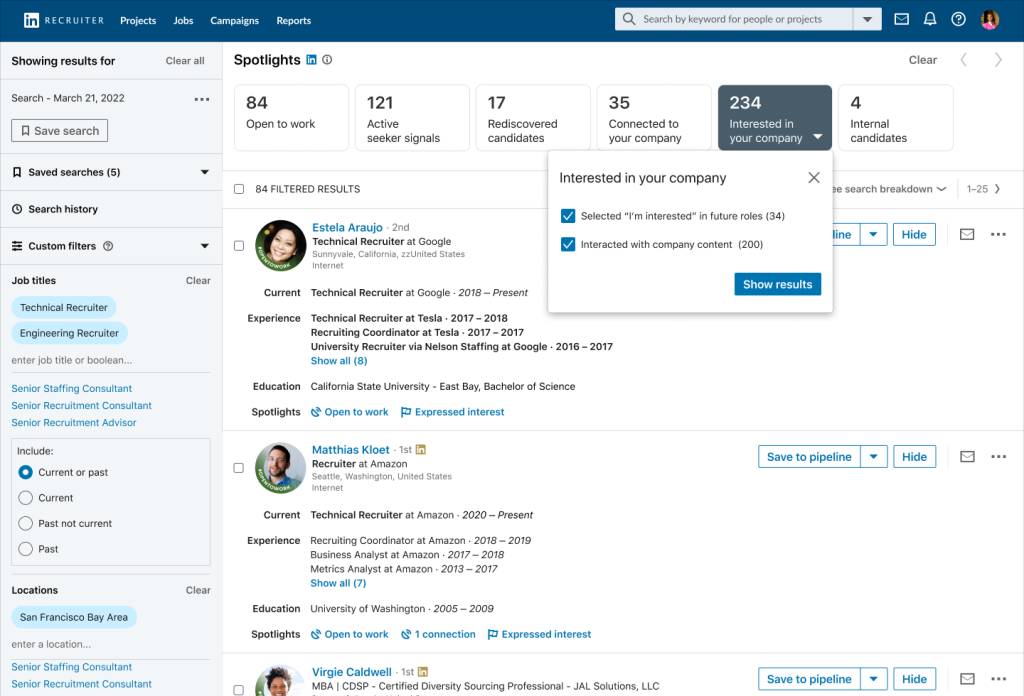People want to join companies with a strong employer brand. In fact, 75% of job seekers consider an employer’s brand before they apply for a job and almost six in 10 employees choose a workplace based on shared values.
Because of that, employer branding remains a critical priority for talent acquisition teams and 57% of recruiters are predicting their investment in employer branding will increase in the coming year, according to our 2024 Future of Recruiting report.
As talent acquisition teams face competition from other companies, difficulty finding candidates with the right skills, and the challenge of engaging a new generation of workers, employer branding is key to helping your company stand out.
LinkedIn offers many ways to showcase your employer brand to attract and hire qualified candidates to your team. Here are five tips to get started:
1. Optimize your LinkedIn Company Page
Your free Company Page is the cornerstone of your employer branding efforts on LinkedIn. Keeping it up-to-date provides your candidates with the information they need to know about your organization.
Take advantage of all the features to promote your employer brand and attract the right talent to your team:
- Complete your Page. Pages with complete information get 30% more weekly views, effectively widening your available talent pool. Make sure your Page has all the basics: a logo, cover image, overview, website URL, industry, company size, location, and a call-to-action button. Collaborate with your marketing team, if applicable, to help ensure that any additions or changes you make will continue to serve your organization’s goals.
- Showcase your Commitments. LinkedIn research found that 68% of candidates align their job search to issues they care about. Highlight your company values in the Commitments section of your LinkedIn Company Page and include your stance on DEI, environmental sustainability, work-life balance, social impact, and career growth and learning. Expand on these commitments with reports, certifications, articles, blogs, and videos that go into more detail so candidates can gauge your authenticity. Job seekers can customize their job search by commitments, giving your job postings more visibility.

- Share your workplace policies. The workplace has significantly shifted in recent years. Include your workplace policies to help candidates understand your guidelines for remote, hybrid, or onsite work as well as location-based pay adjustments. You can also include information about your workplace benefits, including flexible working hours, a home office stipend, and a pet-friendly office.
2. Take advantage of LinkedIn Career Pages
LinkedIn Career Pages are an extension of your Company Page, enabling additional features to showcase your employer brand and attract the right talent to your opportunities. Whereas Company Pages offer basic company information that appeals to customers and candidates alike, Career Pages are tailored specifically to job candidates and give your employer brand the opportunity to shine.
For example, a paid Career Pages subscription allows you to:
- Use the Talent Interest Pipeline feature. Candidates can click the “I’m interested” button on your About tab, Life tab, and Job details page to explicitly signal interest in working with your company. This creates a warm pipeline of candidates that integrates with LinkedIn Recruiter.

- Add a Life page to tell your company’s unique and authentic story. Upload photos and videos, share employee testimonials, and introduce your leadership team to help candidates learn more about your company. You can even build targeted audience pages to create personalized experiences based on each candidate’s LinkedIn profile.
- Expand your reach with Traffic Driver ads. Building employer branding content is only valuable if candidates see it. LinkedIn’s Traffic Driver ads help bring candidates to your Career Page, increase job views and applications, and build followers outside of your existing network. This keeps your company top of mind with your target audience so your sourcing efforts are more effective.

- Use your Analytics page to understand how your page viewers behave. LinkedIn Employer Brand Analytics allows you to track who has viewed your Career Page, who has clicked the “I’m interested” button, and what content your Career Page viewers are engaging with the most. You can also view how many employees you’ve hired and how many you’ve lost to other organizations and discover which companies your new employees are coming from. These insights can help you make more informed decisions around your employer branding and candidate sourcing strategies.
- Drive qualified candidates to your job openings with a personalized Jobs Page. The Jobs tab on your LinkedIn Page allows all members to search for a job with your organization as well as create job alerts for newly posted roles. With a Career Page added to your Company Page, members will see personalized jobs recommended for them as well as discover employees who currently occupy the role. This improved candidate experience can help you engage and convert more candidates for your roles.
3. Engage your talent community
The more your company and employees engage in conversations on LinkedIn, the bigger the opportunity for your employer brand — and talent community — to grow.
For example:
- Post employer branding content to your LinkedIn Page. Candidates, customers, and prospects alike enjoy a behind-the-scenes view of your organization. In fact, employer branding content makes up some of the most engaging Company Page posts on LinkedIn. Share things like your team members’ accomplishments, photos of company events, and a video office tour to offer candidates a glimpse of what it’s like to work at your company. You might even publish a regular newsletter or host LinkedIn Events aimed at your talent community, sharing things like job trends, interview tips, and company news.
- Join the conversation. You can use your Company Page to react or comment on LinkedIn posts, offering a unique opportunity to build and nurture candidate relationships. Congratulate people for their accomplishments, chime in on social issues that align with your company values, and offer insights around successes you’ve had at your company.
- Enable your team members. Your team members can be your greatest advocates — and your greatest opportunity to amplify your employer brand. Empower them to engage with industry influencers, publish articles and newsletters, and share company news on their personal profiles. You can also take advantage of the My Company tab to create an employee-only community on LinkedIn where you can curate suggested content and measure your employee advocacy efforts.
4. Reach targeted candidates with LinkedIn Jobs
LinkedIn Jobs delivers your job postings to the most relevant candidates, giving you the opportunity to get your employer brand in front of new audiences. As this may be a job seeker’s introduction to your company, it’s important to make sure your job posting entices them to apply.
Your brand can stand out by sharing the things that make your company unique, describing a day in the life of an employee, and discussing the projects earmarked for the role. Be genuine and describe what it’s really like to work at your company so the right candidates are excited to apply.
By following some additional best practices, you can write more effective job posts and leave a positive impression on your candidates:
- Use a standard job title. An unusual job title can make it harder for qualified applicants to discover your job post and determine if they’re qualified. Use a standard title like “marketing manager” instead of “marketing ninja.”
- Keep it short, sweet, and easy to read. Overly long job descriptions may prevent candidates from reading qualifications carefully. Aim for 150 words or less, and use bulleted lists. High-performing job posts on LinkedIn are 7% shorter than low-performing job posts.
- Include job responsibilities, qualifications, and skills. Use your job postings to illustrate a day-in-the-life for your role and what’s required to be successful. Most job seekers say that seeing job responsibilities (90%) and qualifications (82%) are critical to their decision to apply. Be specific: Including the skills you’re looking for boosts conversion rates by 11%.
- Make sure it’s inclusive. Show your commitment to candidates from historically marginalized communities with a unique statement about diversity, inclusion, and belonging — and carry that commitment through your entire hiring process.
- Include a pay range. Compensation is a top job consideration for job seekers: 89% say a salary range is critical to their decision to apply. Pay transparency in your job postings can help you attract the right talent, improve your offer acceptance rate, and provide a better candidate experience that boosts your employer brand.
Pro tip: Use “Work with Us Ads” to promote your company and your open roles on your employees' profiles. These personalized and targeted ads get up to 50x higher click-through rates than typical recruitment ads to help build brand awareness. These ads may spur candidates to reach out to your employees and learn more about working at your company, giving your team members an opportunity to advocate for your brand.
5. Become a LinkedIn Recruiter power user
LinkedIn Recruiter gives you unique access to LinkedIn’s members so you can proactively source a diverse, skilled talent pipeline.
Take advantage of key features to improve and promote your employer brand while you source talent:
Take advantage of filters. The “spray and pray” approach to talent acquisition can hurt your talent brand: Candidates don’t like being bombarded with irrelevant roles. Filters in LinkedIn Recruiter help you refine your search so you can identify and reach out to the most qualified candidates. For example, you can filter by skills to identify candidates who have the required qualifications. You can also filter by candidates who are open to work, interested in your company, and connected to someone on your team. Reaching out to the most relevant talent improves the candidate experience, which can help you build a more positive employer brand.

- Check Recommended Matches daily. Recommended Matches automatically searches for talent with the skills and qualities your team is looking for and sends you up to 25 candidate recommendations per day. This makes it easier to discover and engage hidden talent: Candidates found in Recommended Matches are 35% more likely to accept InMails than candidates found in Recruiter alone. Automating these types of repetitive recruiting tasks frees up more of your time for strategic work, like building candidate relationships and promoting your employer brand.
- Make your InMails stand out with AI-Assisted Messages. LinkedIn data shows that personalized InMails see a 40% increase in accept rates. AI-Assisted Messages takes into account all the relevant information on the candidate’s profile, your company, and your job description to build engaging InMails at scale. Personalized messages are more likely to stand out and can help you build meaningful candidate relationships from your first interaction.
Final thoughts: Employer branding is a strategic investment
Employer branding on LinkedIn isn’t just about posting job openings or sharing company updates. It's about strategically positioning your organization as an employer of choice, expanding your talent pool, and fostering meaningful connections with potential candidates.
It’s clear why recruiting professionals rank employer branding as the second-biggest topic shaping recruiting. Investing in employer branding initiatives provides tangible benefits throughout your recruitment efforts and employee lifecycle.
This post was originally published on LinkedIn





